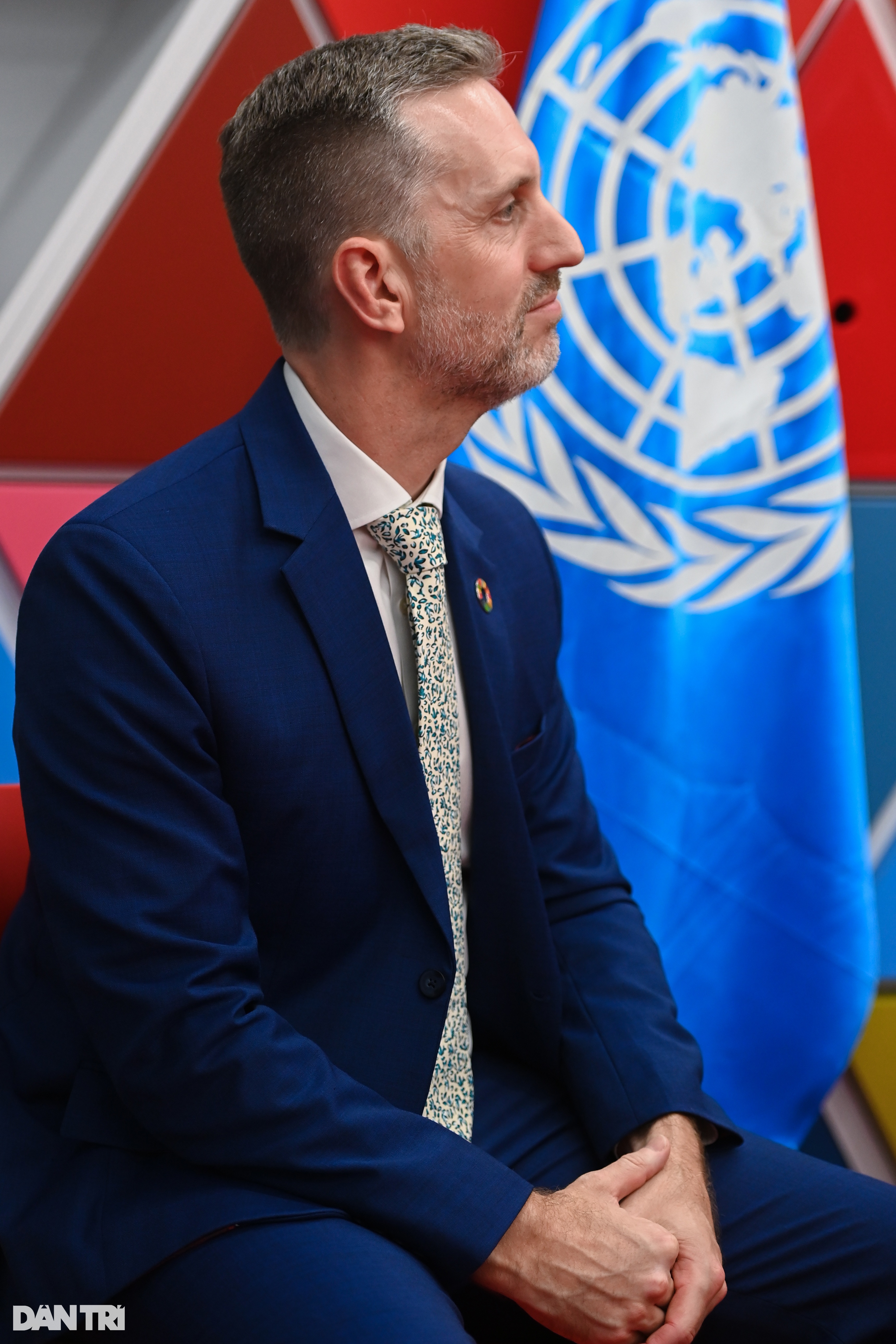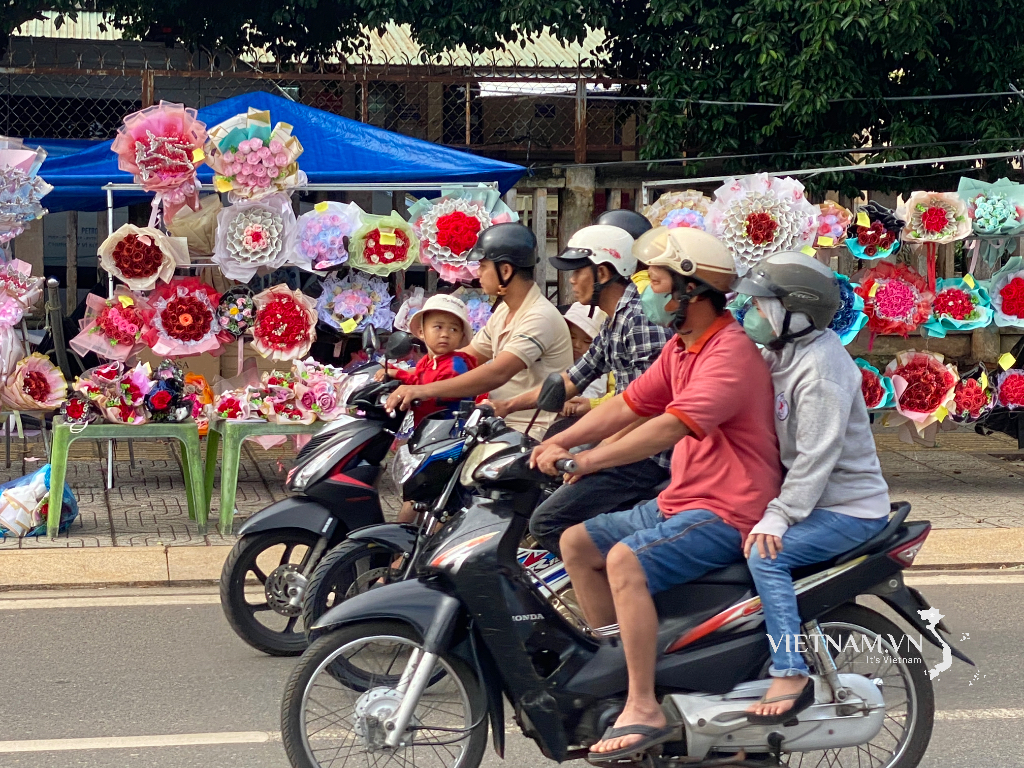Vietnam's fertility rate has dropped to 1.91 children per woman – the lowest level in history.
At the same time, Vietnam is facing one of the fastest aging rates in the world : It is expected that by 2036, people over 60 will account for 20% of the population. These silent shifts are posing major problems for human resources, social security and sustainable development in the future.
The worrying thing is not just the numbers, but the fact that more and more people are unable to have children as they wish, due to being hindered by financial pressure, gender stereotypes, work-life imbalance...
On the occasion of World Population Day (July 11), Dan Tri reporter had an exclusive interview with Mr. Matt Jackson - Chief Representative of the United Nations Population Fund in Vietnam, to review the current demographic picture, shaping a population policy approach that focuses on reproductive autonomy, that is, ensuring that each individual has the right to make decisions about having children according to their own conditions and desires.
The desire to live is limited
How do you evaluate the current population situation in Vietnam, especially the trend of decreasing birth rate?
- Vietnam is undergoing a profound demographic transition. The total fertility rate (TFR) has fallen from around 5 children per woman in the 1950s, to 3.83 in 1989, and is now at 1.91 in 2024 – the lowest level in history.
The average age of women giving birth has also increased to around 28-29 years old. This is a trend that reflects major changes in family patterns, socio -economic conditions and personal life expectations of the younger generation.
But it is not just the numbers that are worrying. It is time to look at the bigger picture and remove the barriers that affect people’s reproductive choices and desires.


Many young people still say they do not want to have children or are satisfied with having few children. In your opinion, is this a personal opinion or is it due to a deeper cause, that there are many factors that make it difficult for young people to build the family they want?
- UNFPA collaborated with YouGov to conduct a survey of 14,000 people in 14 countries and 5 continents to find out one reality: Are people able to build the family they want?
The results show that the rate of adults who cannot fulfill their reproductive intentions is at an alarming level.
One in five people under 50 believe they will not have the number of children they want. Of those who have completed childbearing, one-third say they have fewer children than they had originally hoped.
So the real problem is not that birth rates are falling, but that reproductive desires are not being met and choices are being denied.
Our world is changing rapidly. The global population is forecast to peak in the current century and then decline. This means that society will continue to change, with an increasing number of older people and a shrinking workforce.
Faced with these demographic dilemmas, policymakers and politicians around the world are increasingly concerned about doomsday scenarios and are increasingly critical of women for refusing to align their personal reproductive desires with national population goals.
However, the essence of the current fertility crisis lies in the fact that individuals' reproductive decisions, whether to have children, when to have children and with whom to have children, are being severely hampered.
4 barriers that make young Vietnamese people "afraid to give birth"

The essence of the current fertility crisis lies in the reproductive decisions of individuals.
Specifically, what are the barriers that are causing many young Vietnamese people to feel that having children is a burden?
- There are four main groups of reasons why young people today hesitate or delay getting married and deciding to have children.
First, there is economic instability. According to UNFPA’s State of World Population 2025 report, financial constraints are the leading reason why people are unable to have the number of children they want.
More than half of those surveyed said financial insecurity, job insecurity and the cost of housing or childcare were the biggest barriers.
Second, there is the pressure of gender stereotypes. According to the report, women globally still undertake 3 to 10 times more unpaid care and housework work than men.
In contrast, men are prejudiced if they take time off work to care for children or share household responsibilities, which creates an unequal environment for couples in building a home.


Third, there is the work-life imbalance. Long working hours, limited parental leave and lack of flexibility make raising children overwhelming.
While 186 countries have maternity leave, only 122 have paternity leave, with an average of just nine days.
Finally, cultural norms and gender roles have a strong impact on each person's reproductive decisions.
Women are still expected to marry before a certain age, have children soon after marriage, prioritize family over career development, or are not allowed to talk about issues such as infertility, abortion, or family planning.
We need to understand that young people are not turning away from marriage or having children, they are just struggling with too many barriers. In a society where those choices have become both economically and emotionally risky.

Rather than blaming women and young people for marrying late or not having children, it is important to ask: What are the barriers that are preventing couples and individuals from achieving the number of children they desire and what can we do to remove those barriers?
The Economy of Elderly Care
According to him, is Vietnam at risk of becoming a "second Japan" - that is, entering the process of rapid population aging but in a different context: Japan entered aging when it was already a developed country, while Vietnam is still at the low middle income threshold?
- According to the United Nations definition, a country enters the "aging" population stage when people over 60 years old account for over 20% of the total population. It is forecasted that by 2036, Vietnam will become an "aging" country with over 20 million people aged 60 and over.
This process is happening very quickly, only 25 years (2011–2036), compared to 69 years in the US or 115 years in France. Vietnam is becoming one of the fastest aging countries in the world.
However, the fact that the country has an increasing number of elderly people is not a matter of concern but a great step forward in terms of economy, society and health.
The problem is not age, but how we perceive and create conditions for the elderly to continue living a valuable life.

The problem is not age, but how we perceive and create conditions for the elderly to continue living a valuable life.
Reality in many developed countries like Japan shows that the elderly can still work and participate in social and economic life in their own way, if they are given the conditions.
To do so, two core elements need to be emphasized. The first is lifelong learning opportunities including access to technology and innovation so that the elderly are always updated and useful.
The second is a comprehensive care system that prepares them for a dignified old age. In Vietnamese culture, the elderly often live with their children and grandchildren.
This places a huge burden on women, who have to take care of both children and parents.
Therefore, we need to pay attention to building an economy that cares for the elderly to ensure that the elderly do not become a burden on their families and society. It is important to integrate the care, protection and promotion of the role of the elderly into the country's socio-economic development policy system, creating conditions for them to continue working and contributing to society in their own unique way.
More attention should be paid to the group of female freelance workers.
How does UNFPA assess the proposed policy directions, especially regarding the extension of maternity leave to 7 months for women giving birth to a second child and housing support for women with two children in industrial zones in the draft Population Law being submitted by the Ministry of Health to the Government?
- UNFPA highly appreciates the clear progress in the draft Population Law, emphasizing reproductive rights and the initiative of each individual in decisions related to childbirth.
Specifically, the proposal to extend maternity leave to seven months for women giving birth to a second child is a positive signal to reduce economic pressure and care burden that can affect reproductive decisions.
However, this policy is currently only really effective for formal workers with contracts and social insurance. Meanwhile, more than 60% of female workers in Vietnam are working in the informal sector, including freelance workers, without contracts or insurance and will not be able to access similar benefits.


Therefore, if we want truly equitable and inclusive policies, there needs to be mechanisms to ensure the rights of all groups of women, including women in informal employment, ethnic minority women, migrants and those in precarious employment.
Regarding the housing support policy for women who give birth to two children, this is a positive move but also needs to be placed in the overall context of the support ecosystem.

Lessons from many countries show that financial fertility policies often have only a short-term impact, possibly causing couples to adjust the timing of their childbearing, but do not create a significant change in the total number of children.
What recommendations does UNFPA make for countries at a demographic transition crossroads like Vietnam? How should we approach population policy to both keep up with global trends and ensure the right to self-determination of each individual?
- As the global population reaches 8 billion, the world is facing two major concerns at the same time: One is the fear of population explosion, the other is the decline in fertility. In the face of these changes, UNFPA advises: Governments need to put people at the center of policy making, listening to their real needs and desires.
That means policies need to ensure individual autonomy, from choosing a partner, when to have children, how many children to have, to spacing between births.

Mr. Matt Jackson commented that policy needs to be people-centered.
We need to change our approach from being concerned about demographic indicators to building resilience and proactive response.
A sustainable demographic transition lies not in reaching an ideal or replacement level of fertility, but in creating a society where everyone has the right and the means to determine their own future.
The draft Population Law is a step in the right direction towards realizing that vision and UNFPA stands ready to accompany the Government of Viet Nam on this journey.
Thank you very much for the conversation!
Source: https://dantri.com.vn/suc-khoe/truong-dai-dien-unfpa-nguoi-tre-khong-ngai-sinh-ho-mac-ket-boi-rao-can-20250710180935964.htm




![[Photo] General Secretary To Lam receives Chairman of the National People's Congress of China Zhao Leji](https://vphoto.vietnam.vn/thumb/1200x675/vietnam/resource/IMAGE/2025/8/31/5af9b8d4ba2143348afe1c7ce6b7fa04)
![[Photo] National Assembly Chairman Tran Thanh Man welcomes and holds talks with Chairman of the National People's Congress of China Zhao Leji](https://vphoto.vietnam.vn/thumb/1200x675/vietnam/resource/IMAGE/2025/8/31/9fa5b4d3f67d450682c03d35cabba711)

![[Photo] Marching together in the hearts of the people](https://vphoto.vietnam.vn/thumb/1200x675/vietnam/resource/IMAGE/2025/8/31/8b778f9202e54a60919734e6f1d938c3)
![[Photo] The first meeting of the Cooperation Committee between the National Assembly of Vietnam and the National People's Congress of China](https://vphoto.vietnam.vn/thumb/1200x675/vietnam/resource/IMAGE/2025/8/31/f5ed4def2e8f48e1a69b31464d355e12)


























































































Comment (0)